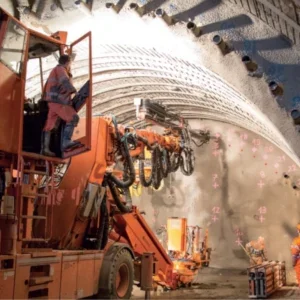Rock classification systems play an essential role in rock engineering and design. They put a number to the quality of the rock mass (i.e. qualifies the quality) so that the rock mass’s behaviour can be predicted; this means engineers will be able to follow the relevant guidelines to design the support systems successfully. Some of the standard parameters used in most classification systems for classification of rock mass include:
- Strength of the intact rock material.
- Rock quality designation (RQD), which is a measure of drill core quality [ = sum of (length of sound pieces >100mm) / total core run length) x 100]
- Parameters relevant to rock joints such as orientation, spacing, weathering
- In situ stress and groundwater (pressure/flow).
The factors that control the jointed rock-mass stability include block size and shape, shear strength of weakness planes, and confining stress. The size of rock blocks in a jointed rock-mass is defined by the number of joints and joint spacings.
Some common rock mass classification systems include: Rock Mass Rating (RMR): developed by Z T Bieniawski during 1972-1973 in South Africa to assess tunnel stability and support requirements. It has been successively refined as more case histories have been examined. Its advantages are that it uses only a few basic parameters relating to the rock mass geometry and mechanical conditions. The RMR system incorporates six basic parameters, which result in an RMR rating in the range 0 to 100:
- Uniaxial compressive strength of the intact rock (15 points)
- Rock Quality Designation (RQD) (20 points)
- Discontinuity spacing (20 points)
- Condition of discontinuity surfaces (30 points)
- Groundwater conditions (15 points)
- Orientation of discontinuities (up to 12 minus points for tunnels)
RMR offers guidelines for selecting rock reinforcement for tunnels which depend on factors such as below-surface depth, tunnel size and shape, and method of excavation.
Rock Tunnelling Quality Index: the Q-system was developed in 1974 by Nick Barton at the Norwegian Geotechnical Institute to determine rock-mass characteristics and tunnel support requirements. It is based on an analysis of 212 hard rock-tunnel case histories from Scandinavia. RMR and Q-Systems use essentially the same approach but different log-scale ratings, as Q-value is the product of the ratio of parameters, while RMR is the sum of parameters. Q-value is applied to estimate the support measure for a tunnel of a given dimension and the usage of excavation by defining the “equivalent dimension” of the excavation.
Geological Strength Index (GSI): Evert Hoek in 1994 introduced the GSI for use in rock engineering to help determine the rock-mass properties of both hard and weak rock masses. GSI resulted from combining observations of the rock mass conditions (Terzaghi’s descriptions) with the relationships developed from the experience gained using the RMR-system. This simple, fast, reliable system represents a non-linear relationship for weak rock mass. It can be tuned for the computer simulation of rock structures and can provide the means to quantify both the strength and deformation properties of a rock mass.
Note: For arriving at appropriate rock engineering results, the application of at least two classification systems is recommended when using these empirical tools.
The most common classification systems used these days are the RMR system and the Q-system. More recently, Palmstrom presented the RMi system in 1995.
Care must be taken with the classification design approach as it is contrary to normal engineering design processes. There are no applied mechanics calculations of stress or displacement, no computations, or information about loads, strains and stresses in the support elements (shotcrete, rockbolts and sets). Therefore, nothing against which to compare field-monitoring data.
Engineers who perform ground support design need to know the limits of classification systems and be familiar and experienced with local geological settings. If details and complexities are neglected when using these systems, catastrophic errors and mistakes may occur.






